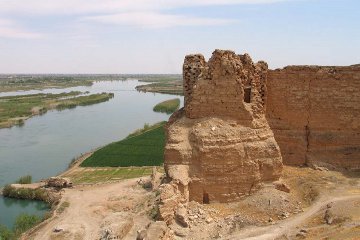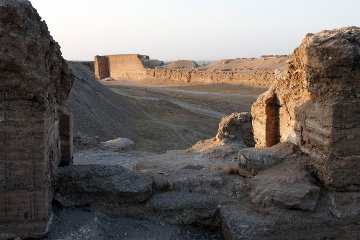Grisly find at Dura Europus
| Dura Europus | 34 44 54.63N 40 43 48.59E | The site is bisected with the western half a good-quality picture, the eastern half a mere blur. I do wish Google Earth would sort their quality out. |
One of the places I would love to visit is Dura Europus - and not just because of the famous painted synagogue (which is in the Damascus Museum anyway) or the Christian church (which is in America, if I remember rightly).

| |
| The citadel of Dura Europus stands on a bluff overlooking the Euphrates River. |
No, it is because of the romance of this outpost of Rome's far-flung empire, perched on a cliff overlooking the Euphrates, its sole reason for existence being that it guarded a crossing of the river used by the camel caravans that passed through Palmyra on their way to the fabled land of Persia. The site is so remote and the surrounding area so barren and uninhabited that the city has escaped the fate of so many ancient ruins and has not been plundered for building materials by later urban developments. Its walls and ramparts still stand, more or less as they were in 256 AD when the Sassanian warriors poured over them and slaughtered the garrison - then rode away and left the city to sleep as the desert sands slowly buried it.
Among the things abandoned by the conquerors and now found by the archaeologists is the massive siege ramp built by the Sassanians and which, in the end, enabled them to overcome the Roman defences. However a ramp was not the only method used by the Sassanians to circumvent the walls: some years ago when the French excavated Dura Europus they discovered a tunnel driven beneath the walls by the besiegers.
Of course a tunnel might be used to secretly convey soldiers into the city, but its usual purpose was to undermine the walls and cause them to collapse. The most common method was to dig the tunnel, propping it up with wooden props as you went. When you had arrived at a suitable spot beneath the wall you set fire to the wooden props and when they burned through, the wall above them collapsed, allowing an attack by the forces above ground.
For this purpose the tunnel had to be fairly shallow - and that meant that the enemy's digging could be heard by the people inside the city. The standard counter-measure was to dig your own tunnel down to the attacker's tunnel, burst in on them and kill as many of the diggers as you could, then keep men down there to prevent anyone coming down and completing the tunnel or setting fire to the props.
Unfortunately, according to the French, just as the Romans were getting ready to burst in on the Sassanian tunellers, their tunnel collapsed, burying nearly two dozen soldiers (or trapping them on the wrong side of the collapse so that they were slaughtered by the Sassanians without being able to flee - though it would seem that they gave the Sassanians enough of a fright that their tunnel was never completed.

| |
| The ruined and half-buried walls of Dura Europus, scene of a desperate struggle between Persian attackers and Roman defenders. |
Recently Simon James of the University of Leicester, England, who has been excavating at Dura Europus for the last thirty years, decided to have another look at the tunnel - and what he found was pretty apalling!
When he looked again at these two dozen skeletons, he found that they weren't poised for attack when the roof fell in, but instead had been neatly stacked one on top of another - indicating that they were either dead or so badly wounded as to be incapable of movement at the time. Furthermore the bodies had not been plundered: their arms and armour were still in place, daggers on hips, cloak buckles on their shoulders. In other words, the stacking had been done in a hurry. Once the bodies had been stacked, they were then set on fire.
This seemed a rather unusual proceeding. Human flesh is not the most combustible of materials and unless the Sassanians had dragged a good deal of firewood down into the tunnel, they could not have expected to cremate the dead - and if they had just wanted to dispose of them to facilitate the tunelling, it would have been easier to drag them out of the tunnel or even just seal off the entrance to the Roman tunnel. Furthermore James found that the Sassanians had built a rough stone wall to block the Roman tunnel before creating the pile of bodies. This led Professor James to look more closely at the signs of burning. He discovered evidence of very intense, but very localised, burning on the skeletons and the military equipment and suggests that the Sassanians had thrown a cloak and some straw onto the bodies as kindling for their fire.
Then, however, he looked more closely and found bits of pitch and crystals of sulphur. His suggestion is that the Sassanians were engaged in "chemical warfare" and that the cloud of sulphur would have driven out any Romans attempting to use their tunnel for another attack on the Sassanians.
Frankly, I don't believe him. Any deterrent effect of the sulphurous smoke would only have endured as long as the fire lasted. Once it was out the tunnel could have been used by the Romans - or, indeed, by the Sassanians in reverse.
He is ignoring the fact that sulphur was used for fumigation for many centuries. Ships entering port with suspected plague or unwanted rodents would have the hatches sealed and burning sulphur in pots placed inside so that the thick and poisonous smoke could purify the ship. Infested houses might also be fumigated with sulphur, as Defoe testifies in the "Journal of the Plague Year".
It seems to me that the bodies were piled up and burned with sulphur because they had started to putrify - that would explain why they were not plundered - and the Sassanians feared that they might cause disease among the besiegers who had to work down in the tunnel. There is one anomaly for which neither James nor I can adequately account, and that is the skeleton of a Sassanian soldier lying on the Sassanian side of the pile of Roman bodies, still wearing a helmet and carrying a sword. James suggests that he was the man detailed to set the fire, but he lingered a little too long and was himself overcome by the burning sulphur.
That is possible - though it seems unlikely that his comrades would have made no effort to recover his body once the fire had gone out and the fumes dispersed. Unless ...
It may be that while the soldier was down carrying out his grisly task his comrades above ground were massing for the final assault. The evidence is that once the Sassanians were over the wall the garrison and the inhabitants of Dura Europus put up a ferocious resistance, fighting literally from house to house, and in the turmoil of death and destruction, with burning houses collapsing on defenders and attackers alike, it is likely that there were many soldiers who disappeared without trace and this man's companions may just have assumed that he died during the attack and never thought to venture down into the abandoned and now unnecessary tunnel to check.
We'll never know, because there were few, if any, survivors from the city and we have no written accounts of its fall. Dura Europus simply ceased to be and once the Sassanians had mounted their horses and ridden away silence fell across the smoking ruins and the grisly secret they held.
© Kendall K. Down 2010





